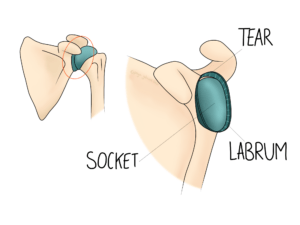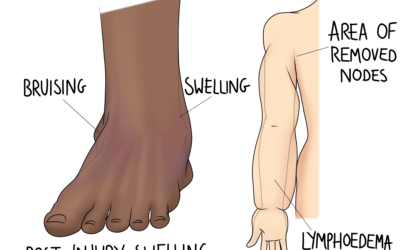Labrum is Latin for “lip”, and in this context, it refers to the lip of cartilage extending from the socket of the shoulder and hip. These ball and socket joints are very mobile, and the presence of the cartilage lip helps to keep them stable without compromising range of movement too much. However, their anatomy leaves them somewhat vulnerable to injury. Osteopaths are qualified to help with shoulder injuries, and minor sports injuries.
Labrum Tear Injuries
These injuries are typically associated with sports and trauma. Repetitive movements, such as throwing or dancing, are a common mechanism of sports injury to the cartilage. Falls or road traffic accidents can also cause a tear, which may affect the back of the joint more than sports injuries do.
The severity of a tear falls on a spectrum. More severe injuries may need surgical intervention, but conservative therapies such as osteopathy may be able to help with more minor cases. Note that surgery is not a quick fix: joint health needs to be sufficient that the body continues the job of healing properly after surgery. Without this final repair stage, the problem is likely to arise again.
Sometimes, a traumatic shoulder labrum tear happens alongside a shoulder dislocation. This degree of injury warrants immediate medical attention, and a comprehensive rehabilitation plan. Your osteopath can help with the rehabilitation element of this plan. In contrast, a labrum injury can be the result of normal age-related degeneration. It is important to understand that although these injuries increase with age, they can still be mitigated through maintaining good health generally, and in terms of joint health. Keeping joints moving through their full ranges on a daily basis is key. Full movement keeps nutrients flowing to the cartilage and slows the degenerative process.
Family history can be quite relevant here. Just like you might inherit one parent’s height, teeth, or nose, you might also inherit the shape of their joints. So if you have a family history of labrum issues, you may be more susceptible to developing them yourself. We ask about relevant familial health issues during your initial consultation, and knowing this information helps us to develop the best plan for you.
Symptoms of Labral Issues
A labral tear may present with:
- pain local to the affected joint
- worsening pain with prolonged movement or weightbearing (for the hip)
- limited movement
- joint clicking or locking
In terms of pain, a labrum tear can present in a number of ways. Pain can be localised to the injury itself, or it may refer further afield. The hip joint typically refers to the groin, so you may have groin pain without symptoms in the hip itself. The shoulder may refer too, but this is usually just to the outer edge of the shoulder. In other cases, there may be no pain at all. However the other symptoms of limited movement and clicking or locking may still be present.
Some other conditions share some common features. For example, a hip labrum injury might be mistaken for Snapping Hip syndrome, or Femoral Acetabular Impingement. A detailed case history and examination help to come to the correct diagnosis, but if we need further information, we can work
How Can We Help the Labrum Heal?
Cartilage is notoriously slow to heal, but we can help to optimise its local environment in a couple of ways:
- improve fluid health
- reduce impact and strain
To improve local fluid health, your osteopath can use gentle, repetitive movement through the joint. The movements encourage new fluid into the area, bringing with it the nutrients needed for healing. Old fluid, full of waste products from the healing cartilage, flushes back into circulation. We can further aid with fluid drainage by
A more holistic view is needed to minimise excess demands on the joint. This approach will be dictated by your specific case. For a labrum tear caused by a throwing injury, it may be appropriate to alter your throwing technique. We will also look at other nearby joints and muscles to determine whether they are also impacting your shoulder. Are you putting too much movement through the shoulder because the upper back is restricted? Your osteopath will assess the body as a whole to find these areas that need to be mobilised. For dancers suffering with a hip labrum tear, the Good Health Centre is well equipped to help manage your pain. We have decades of experience working with dancers from the Northern School of Contemporary Dance, and Phoenix Dance Theatre. You can expect your treatment plan to involve a well-considered route back to exercise, thanks to our professional understanding of dance.
The two-pronged treatment plan is also applicable for labrum injuries associated with osteoarthritis. OA is a condition of cartilage, as is a labral injury, so there is plenty of overlap between management strategies for each. Whether your case is sports related, traumatic, or degenerative, your osteopath will consider your injury in the context of you as a person. We can then devise a completely personalised plan to help you back to where you want to be.
Click here to make an appointment in Leeds for your labrum injury




0 Comments